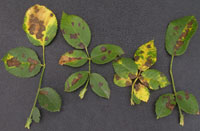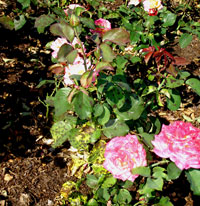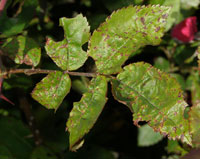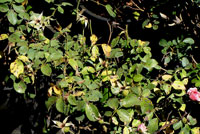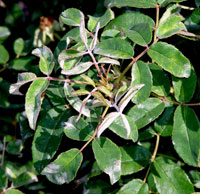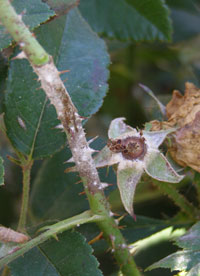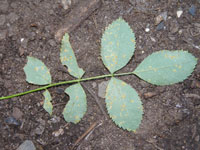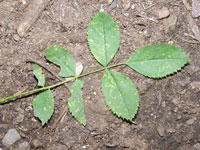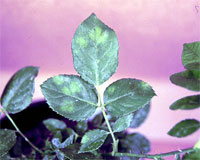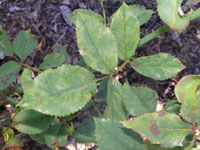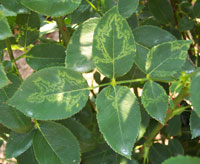Extension > Garden > Diagnose a problem > What's wrong with my plant? > Annuals and Perennials > Roses > Spots on leaves
Roses > Leaves > Spots on leaves
1 of 6
Black Spot
Diplocarpon roseae
- Purplish black spots with uneven or feathery edges on leaves
- Leaves turn yellow around spots
- Leaves fall off
- Sometimes reddish purple or black blisters on canes
2 of 8
Leaf Spot (Anthracnose)
Sphaceloma rosarum, Alternaria alternata, Cercospora sp.,
Colletotrichum capsici
- Small circular leaf spots with a red or purple border and light gray or white center
- In severe infections spots grow together to cover large areas of leaf
- Leaves turn yellow or brown, dry out and fall off
3 of 6
Powdery Mildew
Sphaerotheca pannosa
- Powdery white coating on leaves, stems, flower buds and flower stalks
- Leaf tissue may be tinted red around the infection
- Leaves can be twisted or curved at the site of infection
- Infection often most severe on young leaves
- Typically occurs mid to late summer
- More information on powdery mildew
4 of 6
Rust
Phragmidium mucronatum
- Orange raised bumps on underside of leaves
- Twisted or bent leaves, with orange lesions
- Powdery orange spores released from all lesions and spots
- Severely infected leaves may wilt
- More information on rust
5 of 6
Downy Mildew
Peronospera sparsa
- Purplish red spots or blotches on leaves, spots often will not grow past major leaf veins
- Reddish black spots on canes, petioles and other plant parts
- Grey fuzz on underside of leaf when high humidity
- Leaves turn yellow and fall off plant
- Common in cool wet weather
6 of 6
Virus
Rose Mosaic Virus
- Unusual yellow wavy lines, circles, spots or mottling on leaves
- Symptoms are most obvious in cool weather in spring and fall, may become faint in the heat of summer
- Leaves can be leathery, wrinkled or distorted
- Plants can be stunted or grow poorly



